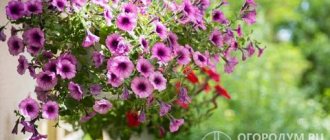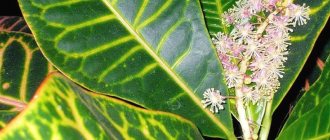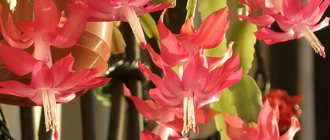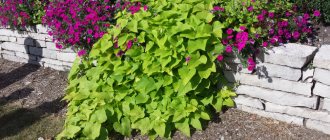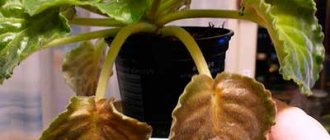One of the most unpretentious and frequently used objects in landscaping is petunia. Landscape designers often use petunia in decoration and create beautiful and at the same time quite durable compositions. These delicate plants were noticed and appreciated back in the 19th century, and then breeders developed several varieties of ornamental petunias. There are still many new hybrids emerging, with larger buds, longer stems and other improved characteristics.
We’ll tell you more about the benefits of landscaping and which varieties of petunia you should choose in this article!
Petunia - description and features
Petunia (or petunia - both spellings are possible) belongs to the genus of herbaceous or subshrubby perennial plants of the Solanaceae family. The height of wild plants varies from 10 cm to 1 meter. Petunia is native to the tropical regions of South America and also grows in Paraguay, Argentina, and Bolivia.
Petunia star
Biological description
The stems of the plant are either erect or creeping, densely branched, with the formation of shoots of the second and third orders. The height depends on the variety and varies from 20-30 cm to 60-70 cm. The leaves are of different sizes, pubescent, of various shapes and colors. The inflorescences are often large, although there are also small-flowered petunia varieties, single, simple or double. The fruit is a capsule and cracks when the seeds ripen.
Benefits of petunias in landscaping
Petunia is extremely popular in landscaping. The abundance of hybrids of different shapes, sizes and shades of flowers allows you to decorate flowerpots, flower beds, gazebos, and other objects. Thanks to their dense foliage and small growth, petunias form a thick and lush carpet.
Petunias in cafe design
The plant has a number of advantages:
- Unpretentiousness and adaptability to various conditions. For this, she is very loved in Russia and even in Siberia and the northern regions she blooms beautifully.
- Long flowering period.
- A huge number of shades, which allows you to create beautiful compositions.
- Versatility - these flowers look equally good in carpet flower beds, hanging flowerpots and multi-tiered flower beds. In addition, petunias are in perfect harmony with other ornamental plants - pelargoniums, fuchsias and even juniper and thuja.
Petunias play a major role in the design of the Dubai Garden of Wonders, which is considered the eighth wonder of the world. Entire houses, towers, and pyramids are decorated with petunias here. They are combined with geranium, calendula and coleus.
Petunia "Black Triumph" large-flowered
What types of petunias and where is best to place them: designer tips
Landscape designers recommend using various forms of petunias for landscaping:
- on loggias, balconies, front areas and patios, large-flowered varieties of petunia, which are planted in pots or containers, would be appropriate;
- varieties of the multi-flower group are suitable for decorating borders; they will create a dense and dense planting;
- It is better to decorate the facade with small-flowered varieties, and if some of the inflorescences are damaged, it will not be noticeable;
- for planting in flower beds and large flower beds, it is better to take abundantly flowering petunias, and hanging containers will look great with hanging varieties.
Petunia Cascade Burgundy
Possible diseases and pests, ways to get rid of them
Petunia Starry Sky (photos and reports from flower growers are described as a common garden crop) is susceptible to typical pests and diseases.
Diseases, pests of petunias and methods of treatment are presented in the table:
| Infection | Signs and consequences | Remedies |
| Aphid | Attacks flowers and buds, feeds on petunia juice. Drops of sticky dew appear on the green parts of the plant, which leads to the development of fungal spores. Insects can infect plants with viruses that are very difficult to treat. | In the early stages, an infusion of soap and tobacco is used. Wash off pests by hand. If ineffective - Fufanon. In case of massive infection - Actellik or Aktara (strictly according to the instructions). |
| Thrips | Both sides of the leaves are affected. Whitish, dry streaks appear on the plates. Flowers wither and buds become deformed. Over time, the entire plant may die. | Treatment with systemic insecticides is used: Konfidor, Aktara. A minimum of 4 treatments will be required with breaks of 7 days. |
| Spider mite | Settles on leaves and inside buds. On the affected shoots, pinpoint lesions and sticky webs appear. The buds die and young shoots become deformed. | When it appears, use dandelion infusion (1 kg of leaves and flowers per 10 liters of boiling water). A glass of the product is diluted in a bucket of water and sprayed. With further spread of the colony, the chemical acaricides Demitan or Apollo are used. Repeat the treatment three times in one day. |
| Powdery mildew | Whitish spots and pubescence appear on the leaves and then the stems of petunias. The plates are deformed and bent. The infection moves from bottom to top through the bushes, inevitably affecting the buds. | Infected areas of bushes are cut off and destroyed. The plant is sprayed with an infusion of mustard (30 g per 10 liters of water) or garlic (a glass of crushed cloves per 10 liters of water). Bio-fungicides Fitosporin, Baktofit, Gamair are also used. |
| Gray rot | The leaves become covered with gray, sticky pubescence, then brown spots, dry out and die. Without treatment with special preparations, petunias can die in a few days. | Stop watering and fertilizing, remove affected leaves and wilted buds. Spraying with Trichodermin is most effective. |
To prevent diseases and breeding of pests, you should follow the watering and fertilizing regime. When the soil becomes acidic and the green part and flowers become wet, the likelihood of infection of the Starry Sky increases significantly. Overmoistening is especially dangerous for petunias during the cool and cloudy season.
Types of petunias
All petunias can be divided into groups according to several characteristics.
According to the shape of the bush
- Bush ones - they can be either low and compact, or spreading - up to 50-75 cm. When growing, it is recommended to pinch the shoots to stimulate branching. Most varieties tolerate wind and rain well.
- Ampelous - characterized by flexible and long shoots. In some hybrids they reach 150 cm. Most of the ampelous varieties are characterized by resistance to unfavorable conditions and bloom for a long time. However, long stems suffer from gusts of wind, so when placing them it is better to choose protected places. They are placed in hanging pots from which the shoots hang down beautifully.
- Cascade - similar to ampelous ones, but differ in shorter and less flexible stems. They grow upward and bend only under the weight of their own shoots. They, like hanging ones, are good to place in vertical flower beds, hanging flowerpots and boxes.
Petunia grandiflora Double Cascade Orchid Mixed
According to the shape of flowers
- Simple - have smooth edges. One bud has 5 fused petals. Such petunias are usually planted in flower beds and used for landscaping parks, squares, and alleys. They look simple, but at the same time very beautiful.
- Terry - created by breeders and have more than 5 petals. Their number varies depending on the variety. Most often, the petals of terry petunias are corrugated, which gives them a special splendor. Such flowers look equally impressive both in flower pots and in flower beds. But when growing them, you should remember that their flowers are very delicate and easily damaged. If the summer is damp and cool, then the flowers may begin to rot from waterlogging. Among terry species, new varieties of petunia have recently appeared.
Multi-flowered petunia Dot Star Dark Vilit F1
By flower size and flowering pattern
- Abundantly flowering (floribunda). This is a whole group of petunias, which are distinguished by large flowers measuring 6-10 cm with long and lush flowering.
- Multi-flowered (multiflora). This group includes varieties and hybrids that are distinguished by abundant flowering, for example, the magnificent Dot Star Dark Vailite of star color. The group includes both compact and spreading varieties. Flowers can be simple or double, 4-5 cm in diameter.
Petunia multiflora Dot Star Deep Pink F1
- Typically, plants of this group are unpretentious, bloom early, bloom for a long time and are characterized by rapid recovery after rains. Most often they are planted in flower beds and containers.
- Small-flowered (milliflora). Sometimes they are also called mini-flowers. They are distinguished by very small flowers, but there are many of them on one plant. The main advantages of this group of petunias are abundant flowering and resistance to adverse weather conditions. Milliflora forms a small bush, quite compact. They are often planted in small flowerpots, boxes, and flower beds.
- Large-flowered (grandiflora). For example, Blue butterflies. The varieties and hybrids of this group are very loved by gardeners. Plants are short-growing (25-35 cm) or tall (up to 70 cm), and flowers are formed up to 13 cm in size, depending on the variety. The peculiarity of large-flowered petunias is their poor resistance to adverse weather conditions - rain, wind. Therefore, they are recommended to be used for landscaping balconies, terraces, and verandas.
Petunia grandiflora Postion Blue F1
In the descriptions of varieties you can find several characteristics at once. Petunia can be both double and large-flowered. Thanks to selection, a rich palette of colors has appeared, which allows any gardener or landscape designer to find something they like.
Petunia grandiflora Daddy Shuga F1
Read on - we’ll tell you about the varieties of petunia and show photos of them.
Bush
Pirouette
Hula Hup
The bush variety is the most popular flower group with erect stems. The smallest representative reaches a height of 30 cm. And tall, spreading representatives of the group can produce shoots up to 75 cm. The diameter of a blossoming bud ranges from 3 to 15 cm, its edges are characterized by different shapes. One bush may have several different shades of buds.
Important! Bush petunias can be cultivated both in open ground and in hanging containers.
Flower growers are most willing to grow:
- "pirouette";
- "Hula Hup".
The best varieties of ampelous petunias: description and photo
Purple Falls
This is a highly decorative second generation species. It is characterized by abundant and beautiful flowering and tolerates rain, wind and hot weather well. The authors of this hybrid recommend using it for placement in hanging baskets, boxes on the balcony or in garden containers. The length of the ampels reaches 80-100 cm, they have a highly branched shape, and the stems are strong. The flowers are large up to 8 cm.
Black velvet
Elite variety, large-flowered. Plant height is about 25-35 cm, flower size is 8 cm in diameter. The bush is spreading, 25-20 cm wide, strongly branches. Flowering begins at the end of May and continues throughout the season until frost begins. Thanks to the bright, almost black color of the flowers, arrangements in hanging baskets and tall flowerpots look luxurious.
Petunia grandiflora Sophistica Blackberry
Rapunzel
An unusually beautiful and delicate plant with hanging stems fully lives up to its name. Young bushes are erect, but as they grow, under their own weight, they hang beautifully over the edges of the basket. Shoots grow up to 80 cm long. The variety is characterized by large flowers up to 8 cm in size, abundant flowering and sufficient drought resistance.
Use in landscape design
As a rule, terry varieties are used outdoors for flower beds and garden vases. It is advisable to plant them in flower beds in the foreground in the center of the compositions.
In the garden, terry petunia bushes look good next to the following plants:
- marigolds;
- snapdragon;
- begonia;
- lefthanded;
- silvery cineraria.
The extraordinary beauty of double flowers is well emphasized by herbaceous plants with decorative leaves
The best terry varieties (photo)
Valentina
Large-flowered super-double variety. The flowers look like carnations, very bright, large and lush. The bushes reach a height of 40 cm, the flowers are very large - up to 12 cm in diameter. Flowering is long - from May to September. To stimulate flowering, plants are pinched. It is recommended to place Valentina in the center of large flower beds, as well as in large flowerpots.
Duo red and white
The flowers are 5-5.5 cm, externally similar to carnation buds. The bush is compact, strongly branches, the stems grow 25-35 cm long. Petunia blooms throughout the summer until the first frost, and is resistant to adverse weather conditions.
Boucle
Hybrid F1, characterized by abundant flowering. The flowers are double, 6-8 cm in diameter. The bush is compact, 35 cm high. The advantages of the Boucle hybrid are drought resistance, unpretentiousness, long and lush flowering.
Petunia in wooden flower pots
Useful tips from experienced flower growers
Over the entire period of petunia’s existence, flower growers have accumulated a wealth of experience in growing it and share it with beginners :
- The bushes are watered strictly at the root , without getting on the foliage and flowers. Spraying from a spray bottle is carried out in the evening to prevent the plant from getting sunburn.
- Overmoistening of the soil threatens the development of putrefactive processes.
- Long petunia branches are pinched to form a compact bush and provide sufficient nutrition for flowers and buds.
- To reduce the amount of fertilizing , the soil is mixed with hydrogel. It absorbs and holds nutrients, which the plant then absorbs.
- The hybrid Starry Sky does not set seed pods and propagates exclusively by cuttings. If you see bags of seeds of this cultivar on sale, you should know that this is a fake.
- Dry and withered flowers are not left on the bush , but cut off with sharp scissors.
- At the end of the flowering period, the shoots are cut to half to stimulate branching and the formation of flower buds.
- To preserve petunia for the next year , by the onset of the first frost, the plants are transferred to individual pots and placed in a warm room. Dry and weak branches are cut off, leaving 10 cm. Petunia successfully winters at a temperature of +10...+15°C and a watering frequency of 2 times a month.
Small-flowered varieties (photo)
Dwarf F1
Plants are compact, 20 cm tall. Flowers are 4-5 cm in diameter. They bloom 9-11 weeks after sowing and bloom profusely. Plants are planted in pots and boxes to decorate balconies and loggias.
Carpet
The variety has more than 20 varieties of flower colors. There are both classic solid shades and more interesting ones, for example, with yellow veins on red and white petals, two-tone, with a white star on a bright background. Plant height is 25-35 cm, flower size is 6-7 cm. It is highly resistant to high temperatures, does not stretch, and is little damaged by rain and wind.
Balcony mixture
Falling stems up to 50 cm long. Flowers are small - up to 5 cm. Flower colors can be varied - red, pink, salmon, purple, etc. Plants are light-loving and drought-resistant. Ideal for growing in hanging pots and balcony boxes.
History of origin
The first discoveries of petunia were recorded by botanists back in the 18th century. For more than a century, hybrids of this extraordinary flower have been decorating the balconies and gazebos of houses and cottages.
Petunia “Night Sky” - “Night Sky” is a completely new hybrid discovery in 2015. The hybrid was bred in Germany by breeders. This variety was nominated for the highest award at European decorative flower exhibitions.
Reference: At the beginning of the 20th century, astronomers discovered a new asteroid and named it after the petunia, “968 Petunia”.
Tall and low-growing varieties (photo)
Tall varieties
They are usually placed in tall flowerpots so that the full splendor of the bush can be appreciated. Here are a few varieties that experienced gardeners recommend.
- Typhoon Cherry F1. This hybrid can be considered gigantic, as the length of the shoots reaches 1.5 meters! The flowers are small - only 5-6 cm. The root system is powerful, so it is recommended to plant this variety in flowerpots with a volume of at least 30 liters.
- Tidal wave parple. The length of the stems is slightly less than that of the Typhoon - about 90-110 cm, but with very good care they can grow up to 150 cm. The height of the bush is no more than 60 cm, the flowers are small - 5-7 cm. The hybrid is very popular among landscape designers and It is often used in compositions. Another difference of the variety is its good adaptability to different weather conditions.
- Opera Supreme Pink Morn. The length of the stems reaches 120 cm, while the bush grows in height by only 10-20 cm. It is recommended to plant in large flowerpots with a volume of at least 15 liters.
Low growing varieties
- Pirouette purple F1. The bushes are low - about 25 cm tall, and branch well. The flowers are densely double, with purple petals bordered by a white jagged stripe. Flowering period from May to October.
- Hula Hup. An elegant large-flowered variety with an abundance of shades and super early flowering. Compared to other large-flowered hybrids, this one blooms 12 days earlier. A bush with a large number of flowers, each 7.5-8 cm in size. The color is purple-blue with a white rim around the edge.
- Lambada. A small and compact plant up to 25 cm high. Blooms profusely from the beginning of May until the onset of frost. The flowers are small, 5-7 cm.
Petunia Lambada Burgundy
Care
A spectacular, delicate plant requires special attention during rooting. In the future, the culture does not require intensive care. Unlike other varieties of the Star Series, Starry Sky independently forms a harmonious bush and does without constant correction.
Nevertheless, for lush, long-lasting flowering, basic care for petunias, fertilizing, and regular watering should be carried out.
Spraying and watering
Watering the Starry Sky bushes is carried out no more than once every 3 days. Increase watering only in extreme heat. Ideally, the soil should not dry out and become covered with a soil crust. Mulching with a layer of several centimeters allows you to maintain looseness, conserve moisture, and additionally nourishes the bushes.
Water for irrigation should not be hard or chlorinated. It is good to use rain, filtered or melt water. Watering Starry Sky petunias is carried out on the soil, without wetting the foliage, stems, and especially the flowers.
Top dressing
Petunia Starry Sky is a bright, ornamental plant, judging by the photo, bearing many buds at the same time. For constant flowering, as well as the laying of new flower buds, it requires enhanced nutrition.
Starry Sky feeding is carried out according to the following rules:
- A small amount of fertilizer for flowering crops can be added to the water with each watering.
- The first portion of fertilizing can be applied to petunias already on the 5th day from planting. At this time, petunias require mainly phosphorus nutrition for root development.
- After 3 weeks, nitrogen mixtures or a complex for flowering garden plants are introduced.
- When the first flowers appear, the bushes will need potassium fertilizing. This stimulation of flowering can be carried out no more than 2 times per season.
In addition to mineral fertilizers, organic compounds can be used for the Starry Sky. Flowering can be perfectly supported by watering the beds with an infusion of wood ash, and instead of nitrogen fertilizers, use diluted bird droppings.
Trimming and pinching
The harmoniously developing Starry Sky bush does not require shaping. But at the seedling stage, like all petunias, it is a single-stem plant. Therefore, to begin branching, a single pinching is carried out.
At the 5-leaf stage, the growing point is removed from the seedlings. As a result, side shoots will appear from the leaf axils. The starry sky branches well on its own, but when stretching the shoots, it may be necessary to re-pinch the tops or shorten the stems.
Optimal conditions
Starry Sky is a variety that is highly sensitive to air temperature. Flowering bushes can develop in a wide range from +10 °C to +37 °C. But the original color of the petals appears only if there are significant differences between day and night conditions.
White spots on a blue background are especially bright when the night temperature drops to at least +15 °C, and preferably to +10 °C. Thus, the flowering of the Starry Night becomes especially bright as autumn approaches. With a slight temperature difference, the pattern is blurred, the spots are blurred across the background.
For optimal development of the bush and maintenance of flowering, choose a place with bright, but slightly diffused lighting for the Starry Sky. The plant should be exposed to light for about 12 hours a day. If there is not enough sunny day, additional lighting is provided with fluorescent or phyto-lamps.
Lack of watering provokes the dropping of flowers and the cessation of planting new ones. The leaves dry out and fall off, and the shoots stop growing. Excessive watering provokes fungal and bacterial infections and contributes to the emergence of soil pests. Therefore, watering is carried out regularly, little by little, focusing on the condition of the bushes and soil.
How to choose petunias
As you have already seen, there are a lot of names, hybrids and types of petunias. In order not to get confused and choose the right name for the petunia variety that will suit and delight you in the garden and on the balcony, use the following rules.
- Please note the manufacturer. The largest producers of petunia seeds are foreign companies. For example, Singenta, Farao, Sakata. In Russia, petunia seeds are practically not produced, and those that are sold by domestic companies are often packaged batches from other manufacturers. At the same time, packaging companies often change the original names to their own. And then it is already difficult to find a specific hybrid, since different packers may have different names for the same original variety. Therefore, it is best to look for stores that sell hybrids in the original manufacturer’s packaging, with the original name and recommendations for growing.
- Choose first generation F1 hybrids. These are the most spectacular petunias, which combine the best characteristics - abundance of flowering, shape of flowers and bush. Such seeds are sold in pelleted form individually. Usually 5 pieces, which are placed in a small test tube so that they are not damaged. F2 seeds – collected from plants grown from F1 seeds. And now they rarely retain varietal characteristics in full or do not retain them at all. Having bought F2 seeds, it is difficult to predict the result.
- If you want to buy cascading or hanging petunias, then choose only F1. Among simple petunias, there are no cascading or hanging petunias.
Petunia grandiflora Supercascade White
Well, to choose good varieties of petunia, pay attention to the expiration date of the seeds, as they quickly lose their viability.
All varieties of petunia are extremely beautiful and interesting, so even the most refined and demanding taste will be satisfied. In addition, new varieties of petunias are appearing, so the flowers are very popular among both amateur gardeners and professional landscapers and designers. LLC “Vashe Khozyaystvo” sells only original petunia seeds from the Czech producer Cerny. The original names of the manufacturer are indicated on the packages. In our catalog you can choose double (Pirouette), large-flowered (Tritunia Blue Star) and other types. You can view the catalog here!
Petunia Pirouette pink terry
Interesting Facts.
- At low temperatures or during rain, the plant does not bloom.
- In order for flower buds to form more often, it is necessary to get rid of dried flowers.
- The word "petunia" is translated from Brazilian as "tobacco". The history of the name is as follows. The naturalist Jean Baptiste Lamarck was the first to write about petunia at the end of the eighteenth century. The new crop was mistakenly named Nicotiana axillaris due to its similarity to tobacco leaves. As other varieties were discovered, petunia became a species in its own right.
